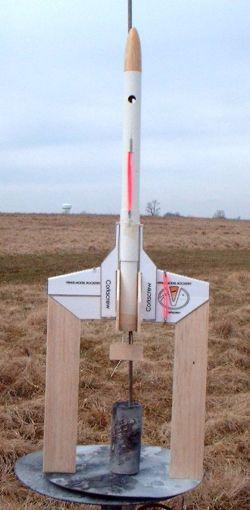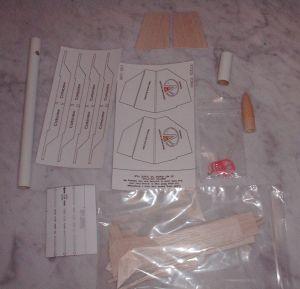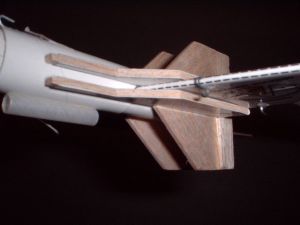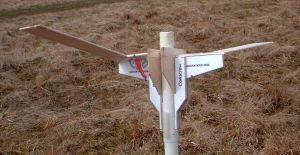| Construction Rating: | starstarstarstarstar |
| Flight Rating: | starstarstarstarstar_border |
| Overall Rating: | starstarstarstarstar_border |
| Manufacturer: | Venus Model Rocketry |

Brief:
A wonderfully simple and reliable helicopter from a very innovative niche
player in the rocketry world. This kit deploys a sort of flop-wing approach to
deploying a pair of blades and comes down nose first/blades up every single
time.
Construction:
I was very impressed with the quality of parts included in this kit especially
the nose cone, which was coated with a very durable polyurethane finish. That
is very important in a helicopter that's designed to land on its nose. This one
can take a beating.
Parts list includes:
- BT-5 body tube
- Hardwood nose cone
- TT-5 sliding tube
- Balsa stock for fins, blades
- Assorted hooks and rubber bands
- Laminate stickers (act as hinges)
The instructions were very well illustrated and easy to follow. While this would probably rate a skill level of 2, I would not rule out using this as a build/fly kit candidate for scouts and school groups if the build was lead by someone who has built a couple of these.
Construction starts with trimming down the blades and fins and gluing them together. It is very important to get a good bond at this stage because this can be a fragile joint and suffer stress upon landing.
 After bonding the fin to the blade, the fin is then cut into two pieces
creating a hinge line. The "hinge" is a glossy laminated label that
is glued across the seam.
After bonding the fin to the blade, the fin is then cut into two pieces
creating a hinge line. The "hinge" is a glossy laminated label that
is glued across the seam.
Next comes cutting and forming the blade restraints, which are a pair of T's that slide back and forth to lock the blades in place. These also get a reinforcing laminated cover.
Tube marking on this is very important, as you want to make sure the fins/blades are as close to 180 degrees apart as possible. It is critical that they be straight/aligned parallel to the body tube.
Fins are then glued to the body tube, being careful to only glue the fin portion--not the aft section that's the flop/blade. Once the fins are secure, slide the TT-5 tube over the BT-5 and slip it down against the fins. Then the blade clamps are tacked onto the TT-5, sandwiching the fin/blade.
 Next come 4 "sub fins", which are little stabilizers that are bonded
to the tops of the blade clamps perpendicular to the clamps.
Next come 4 "sub fins", which are little stabilizers that are bonded
to the tops of the blade clamps perpendicular to the clamps.
The hardware is a bit tricky to install but only because of its tiny size. There are S-hooks to go on the fins and J-hooks to go over the TT-5 and BT-5 tubes. I was a little paranoid about the CA holding under the stress of the rubber bands but everything worked out just fine.
Finishing:
There really isn't anything to finishing this. It is not designed to be painted
and the blade mechanism would probably suffer if painted. The hinges act as
decent decorative decals, so this copter is not exactly an ugly duckling.
Construction Rating: 5 out of 5
Flight:
Flight prep on this is more complicated than comparable Estes kits like the
Sidewinder or Cosmic Cobra and less complex than the typical Rotaroc. Using a
needle, poke a thin thread through the TT-5 and BT-5, taping the ends in place.
Then stretch the rubber band over the J-hooks, stick in the motor, and you're
ready to fly.
For the first flight, I chose a 1/2A3-2 and flew on a day of light (6-7 mph) winds. The flight was fairly straight with only a slight weathercock and no spin whatsoever. The delay was a little early but in a helicopter, early is a good thing.

Recovery:
A common problem with helicopters is their tendency to want to come down
upside-down with the blades down. Because this is a rear-blade design, I was
especially worried about that. In this case though, with the weight of the nose
and the slight delay while the thread burns, breaks loose, and blades deploy,
it flipped over and started a perfect spinning descent.
Total flight duration was around 35 seconds, which is pretty respectable for a 1/2A two blade design.
Flight Rating: 4 out of 5
Summary:
If you're interested in a helicopter recovery model, this would be an excellent
kit to start with. It's cheap, easy to build, very reliable, and performs
fairly well.
PROs: simplicity of design, reliability.
CONs: only two blades, no airfoil or dihedral limiting its performance.
Overall Rating: 4 out of 5
 |
 |
Flights
 |
 |